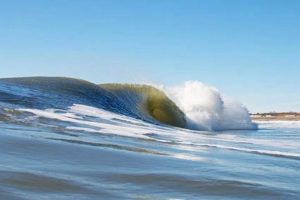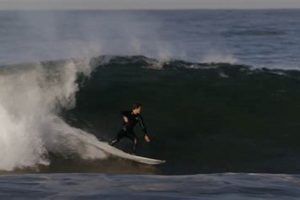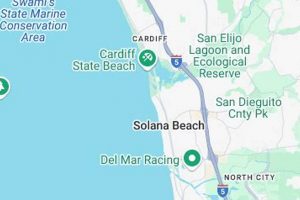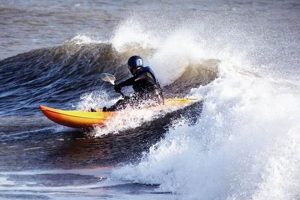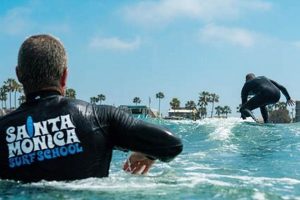A detailed analysis of wave conditions in the coastal area provides crucial information for water sports enthusiasts. This assessment typically includes wave height, swell direction, water temperature, and wind conditions. For example, a notification indicating “small, clean waves with light offshore winds” suggests favorable conditions for surfing.
The value of readily available and accurate coastal condition updates stems from its ability to enhance safety, optimize recreational activities, and inform coastal management decisions. Historically, such information relied on visual observation; current methods often incorporate data from buoys, satellites, and predictive models, enhancing both precision and accessibility.
Understanding these fundamental elements is vital before exploring specific locations or advanced analysis techniques. Subsequent discussions will address localized conditions, interpretation of predictive models, and the utilization of resources to gather relevant data for informed decision-making.
Essential Guidance
The following outlines key considerations for effective utilization of coastal condition updates, promoting safety and optimizing activity planning.
Tip 1: Consult Multiple Sources: Cross-reference different reporting platforms to establish a comprehensive understanding of current conditions. Discrepancies may highlight localized variations or inconsistencies in data collection.
Tip 2: Understand Swell Direction: Swell direction significantly impacts wave formation and break location. Align planned activities with favorable swell angles for the intended coastal area.
Tip 3: Assess Wind Conditions Carefully: Onshore winds often degrade wave quality, while offshore winds can create cleaner, more organized conditions. Monitor wind speed and direction trends.
Tip 4: Evaluate Tide Influence: Tidal fluctuations alter bathymetry and wave breaking patterns. High tide may soften waves, whereas low tide can expose hazards. Consult tide charts in conjunction with condition reports.
Tip 5: Consider Water Temperature: Hypothermia is a risk in colder water. Select appropriate thermal protection, such as wetsuits, based on current water temperature readings.
Tip 6: Recognize Local Variations: Coastal conditions can vary significantly over short distances. Research localized effects, such as reef breaks or sandbars, to anticipate specific conditions at chosen locations.
Tip 7: Prioritize Safety Protocols: Always adhere to established water safety guidelines, including awareness of rip currents, potential hazards, and appropriate emergency procedures.
By carefully considering these recommendations, individuals can enhance their understanding of reported coastal conditions, thereby promoting safer and more rewarding experiences.
These insights provide a foundation for interpreting and applying these reports effectively. The subsequent section will address more advanced analysis and interpretation techniques.
1. Wave Height
Wave height represents a fundamental metric within a coastal assessment, directly reflecting the vertical distance between the crest and trough of a wave. It serves as a primary indicator of surfability and potential hazard levels. Inadequate measurement or misinterpretation of wave height can lead to unsafe recreational activities. For example, an underestimated wave height may result in a less experienced surfer entering conditions beyond their capability, increasing the risk of wipeouts or injuries. Accurate wave height information is crucial for matching skill levels with environmental conditions.
The correlation between swell size and perceived wave height is often influenced by local bathymetry and seabed topography. Nearshore reefs or sandbars can amplify incoming swell energy, resulting in significantly larger breaking waves than initially forecast based on offshore buoy data alone. A coastal report that fails to account for these localized effects provides an incomplete and potentially misleading representation of actual surfing conditions. Furthermore, wave height variability exists within short timeframes due to swell period, grouping, and localized wind patterns. Understanding these complexities necessitates examining wave height trends and incorporating data from multiple sources.
In conclusion, wave height is a critical component that impacts user safety, surf experience, and planning activities. Accurately reporting, interpreting, and understanding wave heights is essential for both novice and professional water sports enthusiasts.
2. Swell Direction
Swell direction constitutes a foundational element within coastal condition assessments, dictating the angle at which open ocean swells approach the shoreline. Its influence extends to wave formation, breaking location, and the overall surfability of a specific coastal area. The effective utilization of a coastal report necessitates a thorough understanding of swell direction and its interaction with local bathymetry.
- Wave Arrival Angle
Swell direction directly governs the angle at which waves interact with a coastline. A swell approaching perpendicularly will typically generate larger, more powerful waves across a broader section of the beach. Conversely, an oblique swell direction may favor specific reef breaks or point breaks, creating localized surfable conditions while leaving other areas relatively flat. For example, a south swell impacting a predominantly west-facing coastline will likely produce optimal wave conditions at south-facing points or coves, while the main beach experiences minimal wave activity. Understanding these directional dependencies is vital for selecting the appropriate surf location.
- Swell Window and Exposure
Coastal geography dictates a specific swell window for each location, defining the range of swell directions that can effectively reach the shoreline. Headlands, islands, or submerged features can block or refract swells from certain directions, significantly altering wave conditions. A coastal report should be interpreted in conjunction with an awareness of the local swell window. Locations with a wide-open swell window receive waves from a broader range of directions, leading to more consistent surf conditions. Conversely, sheltered locations may only experience significant wave activity during specific swell events.
- Wave Refraction and Diffraction
As swells approach the shoreline, they undergo refraction and diffraction, processes that bend and spread wave energy. Swell direction influences the extent and nature of these phenomena. Reef breaks, for instance, often exhibit concentrated wave energy due to refraction, creating powerful, localized surf spots. Diffraction, on the other hand, can cause waves to bend around obstacles, leading to wave energy reaching otherwise sheltered areas. Coastal reports that incorporate refraction and diffraction models provide a more accurate depiction of wave conditions, particularly in areas with complex bathymetry.
- Impact on Rip Currents
Swell direction significantly influences the formation and intensity of rip currents. Oblique swells, in particular, can generate stronger longshore currents and concentrated rip currents in specific areas along the beach. Recognizing the relationship between swell direction and rip current patterns is crucial for water safety. Coastal reports often provide information on potential rip current hazards, which should be carefully considered in conjunction with swell direction data.
In summary, swell direction serves as a critical determinant of wave characteristics and overall surf conditions. The ability to interpret and integrate swell direction data from coastal reports is essential for maximizing surf opportunities and mitigating potential hazards. Understanding the interplay between swell direction, local geography, and wave dynamics is paramount for informed decision-making.
3. Wind Speed
Wind speed is a critical factor in the assessment of coastal conditions, profoundly influencing wave quality and overall suitability for water sports. Understanding its interaction with swell patterns is essential for interpreting relevant condition reports and making informed decisions.
- Onshore Winds and Wave Degradation
Onshore winds, blowing from the ocean towards the shore, disrupt the smooth surface of incoming swells, creating choppy and disorganized wave conditions. This results in a reduction in wave quality, making surfing more challenging and less enjoyable. Strong onshore winds can completely flatten smaller swells, rendering them unrideable. In coastal reports, onshore wind warnings often indicate unfavorable surfing conditions.
- Offshore Winds and Wave Enhancement
Offshore winds, blowing from the land towards the ocean, groom the surface of incoming swells, creating cleaner and more organized wave faces. This can result in longer rides and improved wave shape, particularly for surfing. Light offshore winds are often considered ideal, holding up the wave face and allowing for more advanced maneuvers. Condition reports frequently highlight offshore wind conditions as a positive indicator of surf quality.
- Wind Swell Generation
Strong winds blowing over open water can generate localized wind swells, characterized by short period and choppy conditions. While these wind swells may provide surfable waves in otherwise flat conditions, they typically lack the power and consistency of ground swells generated by distant storms. Coastal reports distinguish between wind swells and ground swells, providing information on swell period and origin.
- Wind Speed Fluctuations and Forecasting
Wind speed is a dynamic variable that can change rapidly, impacting wave conditions within short timeframes. Accurate wind forecasts are essential for predicting wave quality and planning accordingly. Coastal reports often include wind speed forecasts, allowing users to anticipate changes in surf conditions throughout the day. Real-time wind data from coastal weather stations and buoys provide valuable supplemental information.
The interplay between wind speed, wind direction, and swell characteristics is integral to coastal assessments. Interpreting wind data in conjunction with other parameters, such as wave height and swell period, is crucial for optimizing recreational activities and ensuring safety.
4. Tidal Influence
Tidal influence represents a significant variable affecting wave characteristics and breaking patterns, thereby impacting the reliability and utility of coastal condition reports. Tides, driven by gravitational forces, alter water depth, affecting wave propagation, breaking point, and overall wave shape. Consequently, neglecting tidal variations when interpreting coastal condition summaries leads to inaccurate predictions and potential hazards for water sports activities.
The correlation between tide levels and surf conditions manifests differently across various coastal topographies. For example, a shallow reef break may only function optimally during high tide when sufficient water depth exists to prevent waves from bottoming out prematurely. Conversely, a beach break might exhibit better-defined waves during low tide as sandbars become more exposed, promoting consistent wave formation. Many surf reports indicate optimal tide ranges for particular surf spots, allowing users to maximize favorable conditions. Real-world illustrations include specific surf locations that are known to be “high-tide only” or “best at mid-tide,” emphasizing the practical dependence of surf quality on tidal stage.
Integrating tidal information into the analysis of coastal condition reports poses challenges due to local variations in tidal range and the complex interaction between tides, swell direction, and bathymetry. However, failure to account for tidal effects compromises the accuracy of wave predictions and can result in misjudgments regarding surfability and safety. Recognizing the interaction of swell conditions and tide states provides a full overview on coastal conditions. Accurate tidal predictions, coupled with real-time wave data, enhance the interpretive power of coastal reports, contributing to safer and more enjoyable water sports experiences.
5. Water Temperature
Water temperature is a crucial parameter in coastal condition assessments, directly impacting user comfort, safety, and the necessary equipment for water-based activities. Its inclusion in a coastal report provides vital information for individuals planning to engage in surfing or other aquatic pursuits.
- Hypothermia Risk
Prolonged exposure to cold water can lead to hypothermia, a condition where the body loses heat faster than it can produce it. The severity of hypothermia depends on water temperature, exposure time, and individual factors. Coastal reports that omit water temperature data leave users vulnerable to underestimating this risk. The National Weather Service issues specific advisories regarding cold water hazards based on water temperature readings. A report including this allows surfers to anticipate the need for wetsuits of appropriate thickness.
- Wetsuit Selection
Appropriate thermal protection is essential for maintaining body temperature in colder waters. Wetsuits of varying thicknesses provide different levels of insulation, and the optimal choice depends directly on water temperature. Coastal reports that include water temperature data enable users to select the correct wetsuit for the prevailing conditions, enhancing comfort and extending the duration of safe water exposure. Wetsuit manufacturers provide temperature guidelines for their products, requiring accurate data for informed decisions.
- Seasonal Variations
Water temperature exhibits significant seasonal variations, influencing the overall suitability of a coastal location for water activities. During winter months, water temperatures can drop dramatically, necessitating thicker wetsuits or limiting exposure time. Conversely, summer months typically offer warmer water temperatures, allowing for more comfortable surfing with minimal thermal protection. Monitoring seasonal water temperature trends, as provided in many coastal reports, supports long-term planning and activity selection.
- Localized Upwelling
Upwelling is a process where cold, nutrient-rich water rises from the deep ocean to the surface. This can cause localized drops in water temperature, even during warmer months. Upwelling events can significantly impact surf conditions and marine ecosystems. Coastal reports may indicate the presence or likelihood of upwelling based on wind patterns and oceanographic data, providing users with valuable information for anticipating sudden temperature changes.
Water temperature data provides the context for safe participation in water activities. Accurate reports enhance decision-making regarding protective equipment and duration of exposure. Integrating water temperature data helps provide users with comprehensive information.
6. Local Hazards
Local hazards constitute a critical element within a “pb surf report,” directly influencing safety and decision-making for coastal recreation. These hazards, unique to each location, encompass a range of physical and environmental factors that pose potential risks to individuals engaging in water activities. Accurate identification and communication of these hazards within a “pb surf report” are essential for mitigating accidents and promoting responsible coastal use. Examples of local hazards include submerged rocks or reefs that pose collision risks, strong rip currents that can quickly pull individuals offshore, marine life such as sharks or jellyfish, and man-made structures like piers or jetties that create unpredictable wave patterns and potential entanglement risks.
The integration of local hazard information within a “pb surf report” necessitates a collaborative approach involving local authorities, experienced surfers, and oceanographic experts. This collaboration enables the creation of comprehensive hazard maps and risk assessments tailored to specific coastal areas. Real-time reporting of hazards, facilitated through online platforms and mobile applications, allows for timely dissemination of critical information to users. For example, a “pb surf report” might indicate the presence of a recent shark sighting, advise caution in areas known for strong rip currents, or highlight submerged obstacles that become exposed during low tide. Failure to adequately address local hazards within a “pb surf report” can have severe consequences, potentially leading to injuries or fatalities.
In conclusion, the accurate assessment and clear communication of local hazards are integral to the value and effectiveness of a “pb surf report.” By providing users with comprehensive information on potential risks, these reports empower individuals to make informed decisions, minimizing the likelihood of accidents and fostering a safer and more enjoyable coastal experience. Addressing this component comprehensively contributes to responsible coastal usage and management, ensuring the long-term sustainability of recreational resources.
Frequently Asked Questions
The following addresses common inquiries regarding coastal assessments, providing clarity on data interpretation and utilization.
Question 1: What is the primary purpose of a coastal assessment?
The fundamental objective is to provide a comprehensive overview of current and predicted coastal conditions, enabling informed decision-making for recreational activities and coastal management.
Question 2: How frequently are coastal assessments updated?
Update frequency varies depending on the data source and location. Real-time data, such as buoy readings, are typically updated hourly, while forecasts may be updated multiple times daily.
Question 3: What are the key components to consider when interpreting a report?
Wave height, swell direction, wind speed, tidal influence, water temperature, and local hazards represent the critical elements to evaluate for a comprehensive understanding.
Question 4: How reliable are wave height predictions?
Wave height predictions are based on complex models and are subject to inherent uncertainties. Multiple sources and an understanding of localized effects enhance reliability.
Question 5: Where can I find reliable information about local hazards?
Local authorities, experienced water sports enthusiasts, and established coastal safety organizations represent potential sources of information regarding localized risks.
Question 6: How should wind direction be interpreted in relation to wave quality?
Offshore winds generally enhance wave quality by grooming the wave face, while onshore winds tend to degrade wave quality by creating choppy conditions.
A comprehensive understanding of these key aspects ensures more effective utilization of coastal assessments.
This overview of frequently asked questions enhances understanding. Subsequent sections will focus on case studies.
pb surf report
This exposition has detailed the core elements constituting a “pb surf report,” emphasizing the interconnectedness of wave height, swell direction, wind speed, tidal influence, water temperature, and local hazards. Understanding these factors promotes enhanced safety, optimized recreational experiences, and informed decision-making within coastal environments.
Continued refinement of predictive models, data collection techniques, and communication strategies remains paramount for maximizing the utility of a “pb surf report.” Responsible utilization of this information, coupled with adherence to established safety protocols, contributes to the sustainable enjoyment of coastal resources for both current and future generations.


